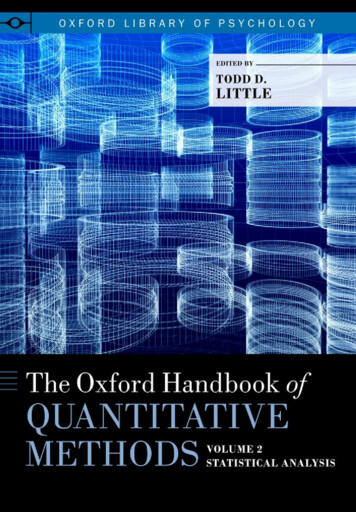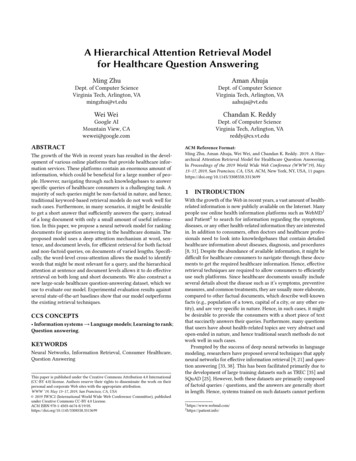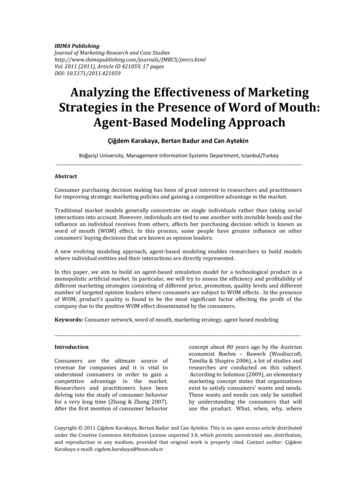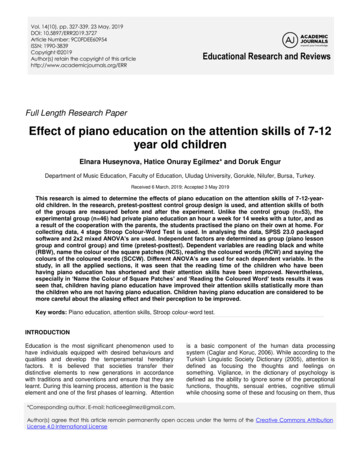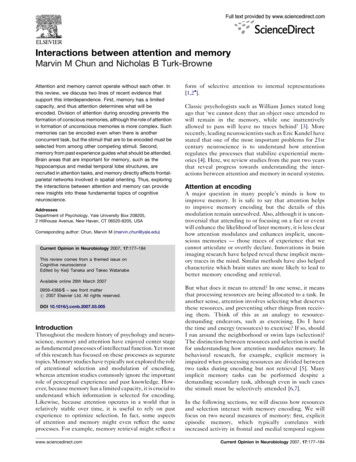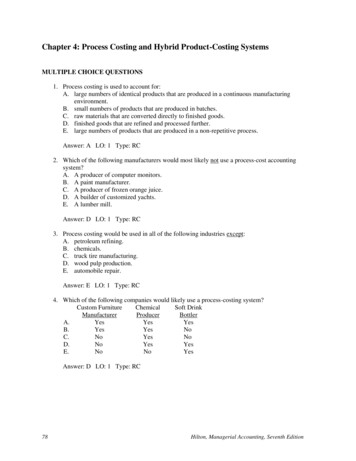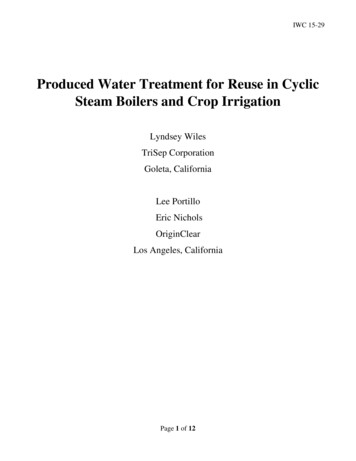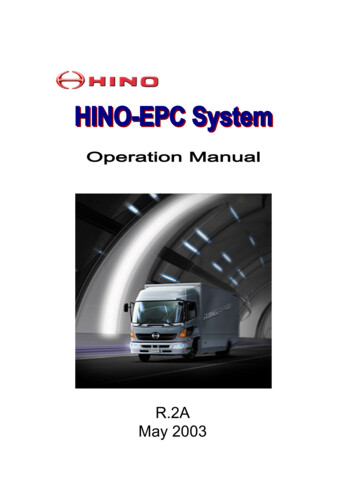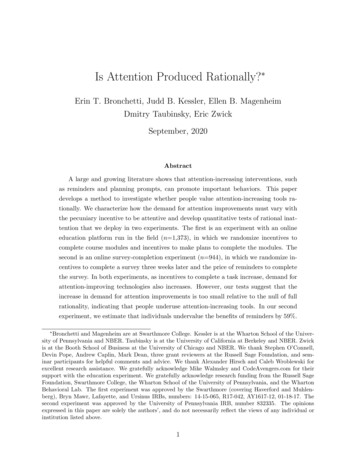
Transcription
Is Attention Produced Rationally? Erin T. Bronchetti, Judd B. Kessler, Ellen B. MagenheimDmitry Taubinsky, Eric ZwickSeptember, 2020AbstractA large and growing literature shows that attention-increasing interventions, suchas reminders and planning prompts, can promote important behaviors. This paperdevelops a method to investigate whether people value attention-increasing tools rationally. We characterize how the demand for attention improvements must vary withthe pecuniary incentive to be attentive and develop quantitative tests of rational inattention that we deploy in two experiments. The first is an experiment with an onlineeducation platform run in the field (n 1,373), in which we randomize incentives tocomplete course modules and incentives to make plans to complete the modules. Thesecond is an online survey-completion experiment (n 944), in which we randomize incentives to complete a survey three weeks later and the price of reminders to completethe survey. In both experiments, as incentives to complete a task increase, demand forattention-improving technologies also increases. However, our tests suggest that theincrease in demand for attention improvements is too small relative to the null of fullrationality, indicating that people underuse attention-increasing tools. In our secondexperiment, we estimate that individuals undervalue the benefits of reminders by 59%. Bronchetti and Magenheim are at Swarthmore College. Kessler is at the Wharton School of the University of Pennsylvania and NBER. Taubinsky is at the University of California at Berkeley and NBER. Zwickis at the Booth School of Business at the University of Chicago and NBER. We thank Stephen O’Connell,Devin Pope, Andrew Caplin, Mark Dean, three grant reviewers at the Russell Sage Foundation, and seminar participants for helpful comments and advice. We thank Alexander Hirsch and Caleb Wroblewski forexcellent research assistance. We gratefully acknowledge Mike Walmsley and CodeAvengers.com for theirsupport with the education experiment. We gratefully acknowledge research funding from the Russell SageFoundation, Swarthmore College, the Wharton School of the University of Pennsylvania, and the WhartonBehavioral Lab. The first experiment was approved by the Swarthmore (covering Haverford and Muhlenberg), Bryn Mawr, Lafayette, and Ursinus IRBs, numbers: 14-15-065, R17-042, AY1617-12, 01-18-17. Thesecond experiment was approved by the University of Pennsylvania IRB, number 832335. The opinionsexpressed in this paper are solely the authors’, and do not necessarily reflect the views of any individual orinstitution listed above.1
1IntroductionA large and rapidly growing body of work shows that provision of ostensibly small “nudges”to people’s attention—such as reminders and planning prompts—can have significant effectson behaviors in economically important domains such as medical compliance, educationalattainment, savings, loan repayment, voting, and charitable donation.1 How can such simpleinterventions have such significant effects? After all, the market already provides individualswith many opportunities to acquire reminder technologies and plan-making tools in theform of various smartphone and computer applications, online calendars, smart-caps on pillbottles, and many others. If these various attention-increasing tools were indeed valuableto individuals, wouldn’t individuals already utilize them, and therefore not be affected byexternal provision of additional attention nudges?One possibility is that individuals can perfectly forecast their attention levels with andwithout various attention-increasing tools—i.e., their attention production function—butthat the costs of the tools exceed the benefits. In addition to any pecuniary costs, reminders and plan-making tools may carry private nuisance costs (see, e.g., Damgaard andGravert, 2018), time costs, or detract scarce attention from other important tasks (Nafziger,forthcoming). Under this “rational inattention” hypothesis (for reviews, see Caplin, 2016;Maćkowiak et al., 2018; Gabaix, 2019), external interventions may be suboptimal as individuals are already equating marginal benefits to marginal costs in setting their optimal levelof attention.2Another possibility is that individuals misunderstand their attention production functionsand, in particular, do not appreciate the value of creating reminders and implementationplans. For example, individuals who are overconfident about their future attentiveness maysystematically underestimate the value of reminders. In this case, despite a rich offering ofattention enhancements by the market, there is still a market failure because individuals’demand for attention-increasing technologies will be below the optimum. In a world withsuch market failures, promoting take-up of attention-improving technologies could increaseefficiency and welfare, as it would lead to investment in attention improvements that arecloser to individuals’ optima.1See, e.g., Nickerson and Rogers (2010); Cadena and Schoar (2011); Milkman et al. (2011, 2013); Altmannand Traxler (2014); Castleman and Page (2016); Bronchetti et al. (2015); Karlan et al. (2016); Calzolari andNardotto (2017); Damgaard and Gravert (2018); Marx and Turner (2019); and see Rogers et al. (2015) fora review. But see also Carrera et al. (2018) and Oreopoulos et al. (forthcoming) for examples of null effects.2Important exceptions include situations in which it is cheaper for a policymaker to create a reminder orplan-making prompt than it is for individuals themselves and situations in which the behavior under consideration generates positive externalities so that the private optimum is different from the social optimum.But even with these nuances, whether individuals’ investment in attention-improving technologies is at orbelow their private optima is a crucial question for cost-benefit analysis.2
This paper develops a method to investigate whether individuals rationally value attentionimproving technologies. We deploy this method in two complementary experiments.Our method builds on the Caplin et al. (forthcominga) characterization of costly attentionmodels using a competitive supply framework. The key insight behind the testable predictions of full rationality that we develop is to examine not only how the attention-increasingtechnologies increase the likelihood of completing the task, but also how pecuniary incentives to complete the task affect individuals’ propensity to obtain the attention-increasingtechnologies.More specifically, the first prediction is a precise condition on how individuals’ willingnessto pay for the attention-increasing technology changes with the pecuniary rewards for thetask. The second prediction is a form of a Slutsky Symmetry condition, which states thatthe impact of task-completion incentives on take-up of the attention-improving technologyis equal to the impact of the price of the attention-increasing technology on the propensityto complete the task.3Guided by this framework, we carry out two experiments. The first is an experiment runin the field with 1,373 students and alumni from six Philadelphia-area colleges who enrolledin an 8-week online coding course.4 The experiment randomized incentives to complete three15-minute coding lessons each week and randomized incentives to make a plan to completethree 15-minute course modules each week. Making a plan involved clicking a link thatautomatically created three 15-minute events in the participant’s online calendar of choicefor the following week and allowed the participant to rearrange the planned events to suittheir schedule.We document three key facts in our first experiment. First, use of our plan-makingtool increased the likelihood of completing coding lessons, especially in the initial weeks.5Second, take-up of our plan-making tool was elastic to the direct incentives for plan-making,but remained below 100 percent, even with the incentives. The combination of incompletetake-up and the positive elasticity suggests that the use of our tool imposes internal or“nuisance” costs on at least some individuals. Third, we find that take-up of our planmaking tool increased with incentives for completing coding lessons.This third result is consistent with the qualitative rational inattention prediction that3See Gabaix (2019) for a discussion about testing Slutsky Symmetry as an empirical strategy for testinglimited attention. See Abaluck and Adams (2017) for an implementation of such a test in the context ofmisperceived product attributes.4Setting our experiment in an educational domain has the appeal that it requires a repeated investmentof time, involves an intrinsic reward, and participants may fail to follow through on their intentions despitebeing highly motivated.5Because online calendars typically have built-in reminder features for planned events, the plan-makingtool can be thought of as providing a combined plan and reminder.3
individuals should value attention-improving technologies more when the rewards for completing a task are higher. At the same time, we estimate that the impact of completion incentives on plan-making is quantitatively too small relative to the Slutsky Symmetry condition,suggesting that participants undervalue the plan-making tool. However, our confidence intervals are wide and do not permit us to reject the null of full rationality at conventionallevels.Our second experiment is an online survey-completion experiment that elicits richer datathat allows us to fully quantify the demand for a reminder technology and to test the firstprediction from our model. The richer data also generates greater statistical power. Thestudy was conducted on Amazon Mechanical Turk (MTurk) with 944 participants. Participants who enrolled in the study were offered a bonus for completing a survey that wouldonly be accessible for a week-long period beginning in three weeks’ time. In the main partof the study, we elicited participants’ willingness to pay (WTP) for a set of three emails reminding them to complete the survey. We elicited their WTP for these reminder emails forvarious bonuses they might receive for completing the survey. We then introduced exogenousvariation in whether participants received the reminders.We find that WTP for reminders increased significantly with the size of the bonus forcompleting the survey. However, this relationship is weaker than the predicted relationshipunder the null of full rationality. The average impact of reminders on completing the surveyis 37 percentage points, which implies that when the completion bonus is increased by 1, rational individuals should increase their WTP for the reminders by 0.37, on average.Instead, we find that participants’ WTP only increases by 0.15, on average. This significantdifference implies that individuals do not fully appreciate the value of the reminders.Collectively, these results show that while individuals are willing to pay more for attentionimprovements when the stakes are higher, they do not do so as much as the full rationalitybenchmark predicts. In other words, individuals appear to undervalue attention-improvingtechnologies. This finding suggests that external attention-increasing interventions can increase efficiency by aligning individuals’ attention levels with their private optima.Our results contribute to the literature in several ways. First, we build off of the supplytheory framework developed by Caplin et al. (forthcominga) to develop a method to assesswhether individuals understand their attention production functions and to test modelsof rational inattention. Despite the recent proliferation of work on rational inattention,surprisingly little work has been done on individuals’ understanding of the limitations oftheir attention.66More work is done on whether individuals’ information acquisition strategies and subsequent behavioralign with the predictions of rationality. See, e.g., Gabaix et al. (2006); Hanna et al. (2014); Bartos etal. (2016); Martin (2016); Dean and Neligh (2018); Ambuehl et al. (2018); Caplin et al. (forthcominga);4
Second, we describe two empirical implementations of our method. We demonstratehow to deploy our method in both field and lab settings, across different domains, andevaluating different attention-increasing technologies. We demonstrate how to evaluatewhether individuals optimally value attention-increasing activities both by directly measuring willingness-to-pay for an attention-increasing technology and by leveraging our SlutskySymmetry condition. Both implementations find evidence that individuals undervalue andunderuse attention-increasing technologies.Third, while a large body of work looks at the impact of attention-increasing technologieson behavior, our main advance is to study individuals’ demand for attention-increasingtechnologies. By studying this new comparative static, we provide a link between thisreduced-form empirical literature and recent advances in the modeling of rational inattention.Better understanding whether individuals invest in their attention optimally is a necessaryinput into a comprehensive evaluation of the costs and benefits of deploying reminders,plan-making prompts, and other behavioral nudges.Perhaps closest to our work, Ericson (2011) and Tasoff and Letzler (2014) conduct labexperiments that find that individuals’ willingness to pay for a rebate exceeds the expectedreturns because individuals’ use of the rebate is low.7 Their results suggest overestimationof future attention to the rebate, although other biases, such as Tassoff and Letzler’s (2014)proposed weak cost-salience, plausibly also play a role. Our approach and results complement Ericson (2011) and Tasoff and Letzler (2014) in a few ways. First, overconfidenceabout one’s baseline level of attention need not imply under-appreciation of the incrementalimpact of helpful technology, and vice-versa. For example, an overconfident individual maybelieve he has a 50 percent chance of completing a task without a reminder, even thoughthe truth is closer to 10 percent. However, he may believe, correctly, that the reminder willincrease the chance of completion by 25 percentage points, leading to a proper valuation ofthe reminder technology. 8 Second, by directly estimating individuals’ (mis)valuations ofattention-increasing technologies, our methods allows to directly speak to how much suchtechnologies should be encouraged through, e.g., subsidies. Third, our Slutsky Symmetryapproach may be more tractable to implement in natural or quasi-experiments than the moredemanding multiple price lists approaches of the prior work. Fourth, our methods are morebroadly applicable to a number of other settings that involve attention-demanding tasks,such as cognitively effortful production (see Section 2).The rest of the paper proceeds as follows. Section 2 presents our theoretical framework.Carvalho and Silverman (2019).7See also Taubinsky (2014) and Ericson (2017) for modeling of economic implications.8See Spinnewijn (2015) for an analogous distinction between baseline beliefs and control beliefs in thecontext of job search.5
Section 3 describes the online education experiment and presents the results. Section 4describes the online survey experiment and presents the results. Section 5 concludes witha discussion of other potential applications of our framework in both laboratory and fieldsettings.2Theoretical frameworkWe consider individuals who choose a level of costly attention, which is needed to (correctly)complete a task. The level of attention can correspond to the likelihood of being attentiveto the task in the future, as in our experiments, or to the likelihood of correctly solving acognitively demanding or psychometric task, as in the lab-experimental literature on rationalinattention (e.g., Dean and Neligh, 2018; Ambuehl et al., 2018; Caplin et al., forthcominga)or the field-experimental literature studying cognitively effortful production (e.g., Dean,2019; Kaur et al., 2019; Bessone et al., 2020). We narrate our model in the context of astructure that most closely resembles our experiments, and then explain how it applies toother settings.In the context of our specific experiments, we think of individuals as making three decisions. First, individuals choose an “attention production function.” In the context of ourexperiments, this is a choice of whether individuals take up our plan-making tool (experiment1) or our reminder tool (experiment 2). Second, individuals select other ways of increasingattention to the task, such as setting their own reminders, engaging in internal “memoryrehearsal” (e.g., Mullainathan, 2002), or asking others to remind them. Third, individualschoose whether or not to complete the task if they remain attentive to it. If they are notattentive, they default to not completing the task.In principle, we could model the first- and second-step choices as occurring simultaneously. However, because the second-step choices are unobservable to the analyst, we formallydistinguish them from the observable choices of attention technologies in our experiments.To formalize, individual i first makes a choice j {0, 1} between attention cost functionsKi0 (µ) and Ki1 (µ), where the argument µ is the probability of being attentive to the task.We let p denote the incremental cost of choosing j 1 over j 0. In our online educationexperiment, p corresponds to the incentives we create for choosing our plan-making tool inthe first experiment, while in our online survey experiment p is the price of our reminders.Individual differences in Ki0 and/or Ki1 could result from individual differences in baselineattentiveness, differences in how well-suited the specific attention-improving technology is toan individual’s needs, or differences in the nuisance costs of reminders and the personal andsocial costs of failing to execute a plan that one creates. The difference between Ki1 and Ki06
could also capture, in reduced-form, the potential indirect costs of having one’s attention toother activities reduced.After choosing j {0, 1}, individuals choose µ, the probability of being attentive tothe task in the future, at cost K j (µ). This corresponds to the unobservable investmentsin attention we described above (e.g., setting their own reminders or engaging in memoryrehearsal). If individuals are inattentive to the task, they default to a 0. If individualsare attentive, they choose whether or not to complete the task, with action a 1 denotingcompleting the task and a 0 denoting not completing the task.For expositional simplicity, we assume here that the benefits of choosing a 1 overa 0 are a deterministic value r bi , where bi 0 is the intrinsic benefit and r 0 isthe observable pecuniary incentive. This assumption is easily relaxed without altering anyresults, as shown in Appendix A.1 and A.2.Given an attention technology K j , the net utility benefit of an attention level µ is thus(bi r)µ Kij (µ). Under the assumption that utility is locally linear in the pecuniaryincentives, rationally inattentive individuals choose j and µ to maximize (bi r)µ Kij (µ) pj.Our main result characterizes testable restrictions of the rationality assumption on a setof statistics that we measure in our two experiments. The first statistic is the willingness topay (WTP) for technology j 1; that is, the highest p at which j 1 is preferred to j 0.Note that if the nuisance cost of j 1 is sufficiently high, this statistic can be negative, evenif j 1 lowers the marginal cost of attention. Average WTP is given by 10W̄ (r) : E max (bi r)µ Ki (µ) max (bi r)µ Ki (µ)µµIn our experiments, we measure the following types of statistics. In our first experiment,we estimate P r(j 1 p, r), the probability of individuals choosing technology j 1 givenfinancial incentives p and r, and P r(a 1 p, r), the probability of individuals doing thetask (i.e., choosing a 1) given incentives p and r. In the set-up here, the latter is simplythe probability of being attentive, but more generally this probability may be smaller thanµ if the net benefits of choosing a 1 are not always positive. In our second experiment,we estimate P r(a 1 j, r), the probability of individuals choosing a 1 if individuals areexogenously assigned attention technology j.Our main assumption—which we state formally in Appendix A.1—is that individualdifferences are sufficiently “smoothly distributed” such that W̄ (r), P r(j 1 p, r), andP r(a 1 p, r) are differentiable functions of p and r. Under this assumption, rationalallocation of attention implies the following testable restrictions on these statistics:Proposition 1. Average willingness to pay for the attention-increasing technology, as a7
function of the task-completion incentive r, satisfiesdW̄ (r) P r(a 1 j 1, r) P r(a 1 j 0, r).(1)drThe likelihood of choosing technology j 1 and the likelihood of completing the task, asfunctions of the task-completion incentive r and the technology price p, satisfy the equalityddP r(j 1 p, r) P r(a 1 p, r).drdp(2)Equation (1) of Proposition 1 states that, if technology j 1 increases individuals’likelihood of choosing a 1 by, e.g., 10 percent under incentive r, then a small increasedr in r should increase individuals’ average willingness to pay for j 1 by approximatelydr/10. The result and intuition follow from the Envelope Theorem. Rationality implies thata small increase dr in the task incentive should be worth P r(a 1 j 1, r)dr to individualsexogenously assigned technology j 1, and should be worth P r(a 1 j 0, r)dr toindividuals exogenously assigned technology j 0. Consequently, the average impact on theWTP for j 1 is (P r(a 1 j 1, r) P r(a 1 j 0, r)) dr.Of course, the first condition in Proposition 1 is a limit result in the sense that it appliesto marginal changes in the task-completion incentive. The corollary below clarifies how thiscondition can be used to evaluate “small” but not “vanishing” changes such as, e.g., a 1increase in the incentive.2d2are negligible.Corollary 1. Suppose that terms of order 3 and dr2 P r(a 1 j, r)( )DefineD(a 1 r) : P r(a 1 j 1, r) P r(a 1 j 0, r).ThenW̄ (r ) W̄ (r) · (D(a 1 r) D(a 1 r )) .(3)The assumptions about negligible terms in the Corollary are analogous to the assumptionsin the canonical Harberger (1964) formula about the impacts of tax changes on consumer andsocial welfare: the change in incentives is not too large, particularly relative to the degreeof curvature in the region of the incentive change. Dividing both sides by and taking thelimit as 0 produces the exact equality in Proposition 1.Figure 1 illustrates the intuition graphically for a representative individual, for the casein which the marginal costs are linear. In this case, the likelihood of executing the taskequals the chosen level of attention µ. In analogy to standard theories of competitive supply,individuals’ choice of µ with attention technology j is determined by the intersection of the marginal benefit curve r b and the marginal cost curve µK j . As in theories of competitive8
supply, the total surplus of an individual with technology j 0 at incentive r is equal to thearea of triangle OAD less the “fixed cost” K 0 (0), which is (r b)P r(a 1 j 0) K 0 (0).Similarly, the total surplus of an individual with technology j 1 is equal to the area oftriangle OAF less K 1 (0), which is (r b)P r(a 1 j 1) K 1 (0). Increasing the incentivesr by an amount increases surplus by an amount ABCD under technology j 0, and byan amount ABEF under technology j 1. The change in WTP for technology j 1 is thusgiven by the area DCEF. The area of DCEF is equal to the height, , multiplied by theaverage of the lengths of DF and CE, which is(D(a 1 r) D(a 1 r )) /2.This gives the expression Corollary 1.In the limit of very small , the difference between P r(a 1 j, r) and P r(a 1 j, r )becomes negligible, and thus the area of ABCD can be expressed as · [P r(a 1 j 1) P r(a 1 j 0)]which leads to equation (1) in Proposition 1.It is important to note that the difference in fixed costs, K 1 (0) K 0 (0), may resultfrom the potential nuisance costs of attention-improving technologies—which is consistentwith negative WTP for reminders by some individuals in our second experiment. Thus, thevalue of a reminder cannot be equated with its impact on the change in expected earningsrP r(a 1). Simply documenting that, for example, individuals’ valuations for a reminderthat increases their chance of earning 10 by 10% is smaller than 1 is not a rejection ofrational valuation of the reminder, since nuisance costs could make a rational individualvalue the reminder less than 1. Our more robust test focuses instead on how individuals’valuations of the reminder change as the pecuniary incentives for being attentive change.The condition in equation (1) requires rich data that is difficult to collect in some fieldsettings and that we do not have in our first experiment. Equation (2) builds on equation (1)by characterizing how the probability of choosing j 1 and the probability of choosing a 1are related to each other. The condition in equation (2) formalizes the basic intuition thatif attention is allocated optimally, then increasing the incentives for choosing a 1 shouldincrease the desire to adopt a technology that increases the likelihood of choosing a 1. Butwhile the qualitative comparative static could still be consistent with individuals under- orover-valuing the benefits of attention technology improvements, the quantitative conditionclarifies exactly how much individuals should seek attention technology improvements.The condition is a variation on the Slutsky Symmetry condition that cross-price elastici9
dties of compensated demand functions must be equal to each other. Intuitively, dpP r(a 1 p, r) is an indication of how adoption of technology j 1 impacts the probability of choosing a 1. In our online education experiment, this derivative is the average impact ofour plan-making incentives on the likelihood of completing course modules. The higher thisnumber is, the higher the impact of our plan-making tool on the likelihood of completing thecourse modules will be. And the higher is the impact of the plan-making tool, the higher isthe impact of a small change in r on its value, as formalized in the first part of Propositiond1. This translates to a higher derivative drP r(j 1 p, r).2.1Applications to other settingsOur framework can be implemented for a variety of other attentional tasks studied in laband field experiments. Suppose that b 0 is fixed so that the expected payoff is simplyµr. This corresponds to psychometric experiments such as those of Dean and Neligh (2018)and Caplin et al. (forthcominga), or settings where employees exert mental effort under apiece-rate incentive scheme (e.g., Dean, 2019; Kaur et al., 2019; Bessone et al., 2020). Theobservable choice of K j can capture the choice of task difficulty, decision aids, or the level ofdistraction in the environment. The choice of µ conditional on j corresponds to various formsof exerting mental effort not directly observable to the analyst. The observable outcome asimply captures whether the individual executed the task correctly or not.Our modeling of attention as a production technology makes use of results in Caplinet al. (forthcominga), which shows that standard rational inattention models (e.g., Sims,2003; Matejka and McKay, 2015; Caplin and Dean, 2015; Caplin et al., forthcomingb) can berepresented by a production model in which individuals pay a cost to obtain a probability µof taking the right action. The Caplin et al. (forthcominga) results imply that our modelingframework makes minimal assumptions about the structure and dimensionality of attentionallocation.2.2Deviations from the full-rationality benchmarkDeviations from the full-rationality implications derived in Proposition 1 can be used toquantify behavioral biases. Misperception of attention production functions will lead toviolations of the conditions in Proposition 1. For example, if individuals are overconfident about the likelihood of being attentive in the future, they will undervalue improvements to their attention production function. In particular, if individuals consistentlybelieve their likelihood of being inattentive is only θ 1 as high as it actually is, thendddW̄ (r) θ [P r(a 1 K1 , r) P r(a 1 K0 , r)] and drP r(K1 p, r) θ dpP r(a 1 p, r).dr10
Deviations from the conditions in Proposition 1 can thus provide estimates of stronglyparametrized models of overconfidence. We formalize these claims in Appendix A.3.Of course, such a parametric model of overconfidence need not be the only possiblemicro-foundation. For example, individuals could under-appreciate the efficacy of particularattention-increasing technologies, but be well-calibrated about their level of attention inthe absence of attention-increasing technologies. E.g., individuals might think that theirlikelihood of being inattentive is θ0 as high as it is under technology K 0 , and they mightmisperceive the incremental value of K1 by (1 θ)(K1 K0 ). In this case, our methods identifyθ (whereas methods such as those of Ericson (2011) and Tasoff and Letzler (2014) identifyθ0 ). Rejection of the conditions in Proposition 1 rejects the rational inattention assumptionin a robust way that is not tied to any particular parametric model of misperceptions.3Online education experimentOur first experiment was designed around the Slutsky Symmetry test in Equation (2) ofProposition 1. It investigates how individuals respond to incentives that reward task completion and incentives that reward
support with the education experiment. We gratefully acknowledge research funding from the Russell Sage Foundation, Swarthmore College, the Wharton School of the University of Pennsylvania, and the Wharton Behavioral Lab. The rst experiment was a

